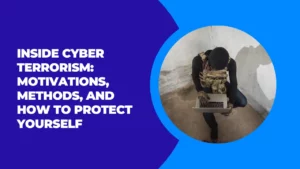Physical Address
304 North Cardinal St.
Dorchester Center, MA 02124
Physical Address
304 North Cardinal St.
Dorchester Center, MA 02124

Cyber terrorism has become an increasingly prevalent threat in recent years and has the potential to cause significant damage to individuals and businesses alike. In this blog, we will take a deep dive into understanding cyber terrorism, its motivations, methods used by attackers, and notable instances of such attacks.
We will also explore the impact that cyber terrorism can have on both individuals and businesses. Lastly, we will provide some tips on how you can protect yourself from cyber terrorism. So whether you’re a small business owner or an individual with an online presence, this post is for you. Read on to find out how you can safeguard yourself against this growing threat.

The world of cybercrime has become increasingly dangerous, with cyber terrorists now utilizing technology to threaten and cause harm. Their targets are not limited to individuals but extend to computer systems, networks, and critical infrastructure.
Exploiting vulnerabilities in software and hardware, cyber terrorists have the ability to wreak havoc on a massive scale. In response, governments and law enforcement agencies, such as the FBI and the Department of Homeland Security, have been working tirelessly to combat this rising threat to national security. However, cyber terrorism continues to evolve, posing new challenges and risks every day.
It is crucial for individuals and organizations to stay informed about the latest methods and tactics employed by these attackers. By understanding the complexities of cyber terrorism, we can better protect ourselves and our digital assets from future attacks.
The term “cyber terrorism” refers to the utilization of technology to carry out acts of terrorism. This involves launching attacks on computer systems and networks with the intention of causing disruption or harm. Cyber terrorists aim to intimidate, coerce, or influence governments or societies through their actions.
The motivation behind cyber terrorism is often ideological or political, as these individuals seek to advance their beliefs or agendas. The consequences of cyber terrorism can be devastating for both individuals and organizations, with potential impacts ranging from financial loss to compromised national security.
It is crucial to understand the definition of cyber terrorism in order to effectively combat and protect against these threats.
The landscape of cyber terrorism has continually evolved alongside the rapid advancements in technology. With the internet serving as a global platform, cyber terrorists have been able to carry out their attacks with unprecedented reach and efficiency.
These malicious actors have become increasingly sophisticated in their methods, exploiting vulnerabilities in software and hardware to infiltrate systems and networks. Moreover, the rise of social media has provided a fertile breeding ground for the spread of extremist ideologies, further amplifying their influence.
Additionally, the growing interconnectedness of devices has significantly expanded the attack surface for cyber terrorists, making it easier for them to target individuals, organizations, and even critical infrastructure.
As we move forward, it is crucial to remain vigilant and stay updated on the latest information security practices to mitigate the risks posed by these evolving threats.

Cyber terrorists are motivated by various factors, including political, ideological, and financial reasons. Some individuals engage in cyber terrorism to promote a specific political or ideological agenda.
They may target government institutions, corporations, or individuals who they perceive as a threat to their cause. On the other hand, there are cyber terrorists who are primarily driven by financial gain.
These individuals may carry out ransomware attacks or engage in other forms of online extortion to obtain monetary benefits. The anonymity provided by the internet serves as a safe haven for cyber terrorists to operate without being easily traced or identified.
It is crucial to understand these motivations in order to effectively prevent and respond to cyber terrorism in the future.
Cyber terrorists often perceive themselves as activists or freedom fighters, justifying their actions as resistance or retaliation. They firmly believe that their attacks can inflict significant damage on their targets, aiming to make a lasting impact. Some cyber terrorists are motivated by the desire for recognition or notoriety, seeking validation for their actions.
Psychological factors, such as a sense of power or revenge, can also play a role in shaping their mindset. It’s essential to comprehend the mindset of cyber terrorists to effectively counter their actions and prevent future attacks.
By understanding their motivations and psychological factors, law enforcement agencies, intelligence organizations, and cybersecurity professionals can better analyze and respond to threats in cyberspace.
Read More: Achieving Cyber Hygiene in 2024: A Checklist for Individuals and Organizations

Cyber terrorists employ a range of tactics to carry out their attacks. These methods include malware attacks, phishing scams, and denial-of-service (DDoS) attacks. They also utilize social engineering techniques to exploit human vulnerabilities.
Their targets often include critical infrastructure, government entities, and financial systems. Staying updated on the latest cybersecurity best practices is crucial for protection against these diverse methods of cyber terrorism.
It is essential to understand the evolving landscape of cybercrime and the tactics employed by hackers. The FBI and the Department of Homeland Security (DHS) play a significant role in combating cyber terrorism and ensuring the security of cyberspace. Organizations should invest in effective antivirus software and follow the guidelines provided by cybersecurity experts in order to safeguard against future attacks.
The banking industry, in particular, must remain vigilant due to the potential for monetary gain through cyber terrorism. The previous year witnessed an increase in sophisticated cyber attacks, and it is vital for individuals and businesses alike to prioritize information security.
The definition of cyber terrorism has expanded to encompass not only individual attacks but also acts of cyber warfare perpetrated by nation-states.
Governments, military personnel, and private organizations worldwide are at risk from cyber threats originating from various countries, including Russia, Poland, and Australia. The constant evolution of cyber terrorism requires continuous adaptation and proactive measures to counter these threats.
Cyber terrorism involves various tactics that are used to carry out attacks. One common tactic is malware attacks, which utilize malicious software to gain unauthorized access or cause damage. Phishing scams are another tactic employed by cyber terrorists, where individuals are tricked into divulging sensitive information through deceptive emails or websites.
Denial-of-service (DoS) attacks are also commonly used, overwhelming target systems with traffic and rendering them inaccessible. Social engineering is another tactic, involving the manipulation of individuals into revealing sensitive information or performing certain actions.
Additionally, cyber terrorists may exploit vulnerabilities in software or hardware to gain unauthorized access. These tactics highlight the diverse methods used by cyber terrorists to carry out their attacks, emphasizing the importance of staying vigilant and implementing effective cybersecurity measures.
Numerous significant cyber terrorism events have taken place in recent years, showcasing the pervasive threat of this modern-day warfare. One notable instance is the Stuxnet worm, which aimed at Iran’s nuclear program and caused physical damage to critical centrifuges.
The WannaCry ransomware attack stands out as it infected hundreds of thousands of computers globally, encrypting data and demanding a ransom. Another prominent case is the Sony Pictures hack, attributed to North Korea, which resulted in the leak of highly sensitive information, including unreleased films and confidential employee data.
Additionally, the Ukraine power grid cyber attack disrupted the electricity supply to thousands of homes, highlighting the potential impact on physical infrastructure. These instances highlight the severity and complexity of cyber terrorism, emphasizing the urgent need for robust cybersecurity measures and international cooperation to counter these evolving threats.
The deployment of the Stuxnet worm by the United States and Israel aimed to disrupt Iran’s nuclear program. The NotPetya ransomware attack initially targeted Ukrainian businesses but quickly spread globally, causing widespread damage.
The Islamic State effectively used social media platforms for recruitment and radicalization purposes. Fancy Bear, a Russian hacking group, has been implicated in various cyber attacks across the world. Additionally, the North Korean government has been linked to cyber attacks targeting South Korea and other nations.
These case studies highlight the diverse capabilities and motivations of cyber terrorists, emphasizing the importance of robust cybersecurity measures. By studying these major cyber terrorism events, we can gain valuable insights into the evolving nature of this digital threat landscape.

The impact of cyber terrorism on individuals and businesses can be devastating. Cyber terrorism poses significant threats, ranging from financial loss to reputational damage. Individuals can fall victim to identity theft or become targets of online harassment, leaving them vulnerable and violated.
For businesses, the consequences include disruption of operations, loss of customer trust, and potential legal liabilities. Cyber attackers can steal sensitive data, compromising the integrity and security of personal and business information.
It is crucial for individuals and businesses to prioritize information security and take proactive measures to protect themselves against these threats. The Department of Homeland Security (DHS), FBI, and other security agencies play a vital role in combating cybercrime and ensuring a safe cyberspace.
Implementing robust antivirus software, staying updated on information security best practices, and collaborating with law enforcement agencies are essential for safeguarding personal and business interests. With the threat landscape constantly evolving, protecting against future attacks requires ongoing vigilance and awareness.
Cyber terrorism can have devastating personal consequences, ranging from identity theft and financial loss to damage to personal reputation and privacy. The emotional distress and psychological trauma caused by these acts of terror are often long-lasting. Moreover, cyber terrorists can also target critical infrastructure, such as healthcare systems or transportation networks, leading to physical harm.
Protecting oneself from such threats is crucial. Taking basic precautions like using strong passwords, keeping software up-to-date, and being cautious when clicking on links or opening attachments can go a long way in safeguarding against cyber attacks.
By staying informed about the latest security measures and being proactive in implementing them, individuals can minimize the personal impact of cyber terrorism.
The effects of cyber terrorism on business operations can be devastating. Attackers employ various tactics such as denial-of-service attacks, data breaches, and ransomware attacks to disrupt operations and cause significant financial loss.
These attacks can lead to a loss of revenue and damage to a company’s reputation. Moreover, businesses may face legal and regulatory consequences, including fines and lawsuits. To protect against cyber terrorism, organizations must implement robust cybersecurity measures, including password management, firewalls, and employee training.
Collaboration with government agencies and other businesses can also help improve cyber threat intelligence and response capabilities. Building strong defenses against cybercrime is crucial for protecting the stability and integrity of the business environment.
To protect yourself from cyber terrorism, it’s important to keep your software updated and use strong passwords. Be cautious of suspicious emails or messages asking for personal information.
Utilize antivirus and firewall software, and consider using a VPN. Regularly back up important data and be prepared to disconnect from the internet in case of an attack.
While it is not possible to fully safeguard against cyber terrorism, cybersecurity measures can significantly reduce the risk and mitigate the impact.
Prioritizing cybersecurity awareness training, regularly updating security software, and implementing multi-factor authentication are crucial steps in protecting against cyberterrorism.
In conclusion, cyber terrorism is a real and evolving threat in today’s digital world. Understanding the motivations behind cyber terrorism and the diverse methods used by cyber terrorists is crucial in order to protect yourself and your business from potential attacks.
While it may not be possible to fully safeguard against cyber terrorism, there are steps you can take to minimize the risk. This includes implementing strong security measures, regularly updating software and systems, and educating yourself and your employees about cyber security best practices.
By staying informed and proactive, you can greatly reduce the chances of falling victim to cyber terrorism. Stay vigilant and prioritize the safety of your online presence.